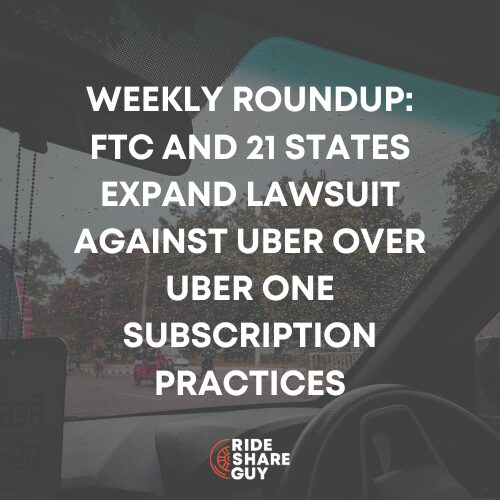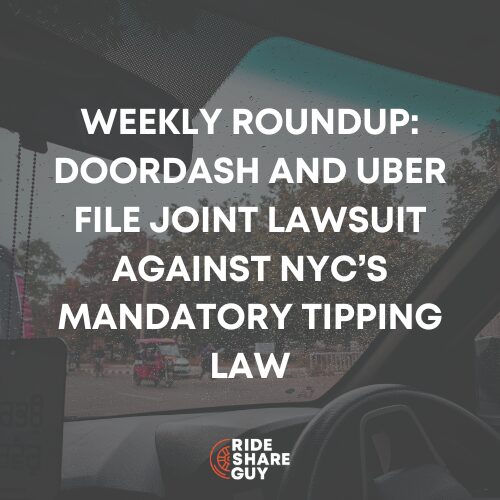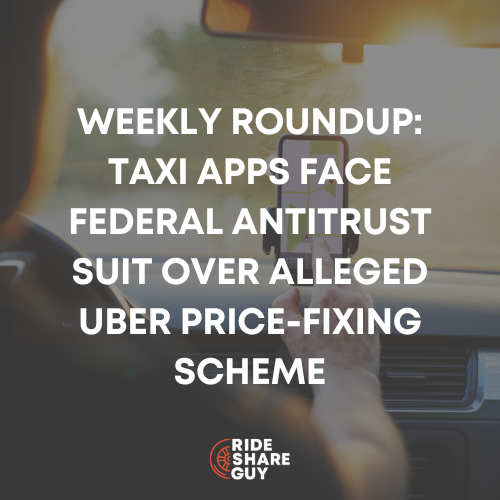In this week’s round up, Uber and Lyft are nervous about the potential outcome of California Assembly Bill 5 (AB5) and it shows. Senior RSG contributor John Ince covers this news and more below.

Uber and Lyft Pushed Drivers To Email State Legislators To Oppose Bill That Would Make Them Employees [SFist]
Sum and Substance: Both Uber and Lyft are anxious about a bill that could potentially make California the first state where rideshare drivers — and all delivery-app drivers — can’t be classified as contractors.
Assembly Bill 5 follows on a recent state Supreme Court decision, known as the Dynamex decision, that has strengthened state law around independent contractors. Two tests that came out of the decision threaten to upend Uber and Lyft’s business model, and after penning an op-ed in the Chronicle (co-signed by Uber CEO Dara Khosrowshahi and Lyft co-founders Logan Green and John Zimmer), the two companies called on their California drivers in recent weeks to email state legislators to oppose AB 5, saying they want to remain independent.
In order to qualify as independent contractors, the workers must be doing “work that is outside the usual course of the hiring entity’s business,” they must be free from control by the hiring entity in the performance of said work, and they must be “customarily engaged in an independently established trade, occupation, or business of the same nature as that involved in the work performed.” Uber and Lyft have an obvious problem here: drivers are the core of their business and their biggest revenue source, and they’ve spent the last five or so years of their existence arguing that they are software companies, even though they don’t sell software — they sell rides. And in order to qualify for the latter test, the drivers would need to have already been in the taxi trade, technically.
My Take: It’s a sign of the times that companies like Uber and Lyft would have such confidence in their power to manipulate what their drivers think that they would put together this program to turn natural allies of AB5 into opponents. And the crazy thing is – it’s working. 30,000 Lyft drivers contacted their legislators essentially parroting the talking points given to them by Uber and Lyft. Recode talks about it here, asSome Uber and Lyft drivers say they accidentally petitioned against their own rights. As a result the eventual outcome of AB5 remains in doubt.
Related article: Ab5 Uber – Everything You Need To Know
If Uber Wants It It’s Bad [Splinter]
Sum and Substance: If you are negotiating with someone, and they are willing to make concessions as long as they keep one, single, big thing, then that is the thing that is important. Duh. Today, that thing is “your ability to live with human dignity.”
Uber and Lyft, the vanguards of the “gig economy,” have staked their entire business model on the ability to pretend that their employees are not employees. In the olden days, it was assumed that someone who works for your company is your employee. In our wondrous modern technological age, companies have figured out that if you call your employees “independent contractors,” you don’t have to give them a lot of stuff—workplace protections mandated by law, health care benefits, steady schedules, etc. Also they can’t unionize! This is wonderful, from the perspective of companies. It has made investors and executives very rich. The only cost has been that it casts millions of people into a hellish netherworld in which the fundamental state of being is an inability to cobble together a steady, dignified, sustainable life, no matter how hard you try. This is the “gig economy” at work.
People who understand labor issues have long understood that the most direct and effective way to break this modern-day indentured servitude with a smile is to force these modern day companies to classify their workers as employees. All these companies have done is to find a nifty way to save themselves billions of dollars by circumventing U.S. labor and employment law, which was designed with “employees” in mind. Update the laws and the system will once again work, at least on a very basic level, as it is supposed to.
My Take: Good article. The author understands negotiation much better than all the drivers posting on Facebook groups who say they really value their independence. Uber and Lyft know that if they confuse the issue enough then that’s a win for them. So, many drivers unwittingly become shills for Uber and Lyft.
New Mobility: Present and Future [Shaller Report]
Sum and Substance: A Few of My Favorite Facts:
There were 3.2 billion ride service passenger trips in 2018 in the U.S. Combined taxi and ride service trip volumes more than doubled since ride services came on the scene in 2012, from 1.4 billion passenger trips in 2012 to 3.9 billion in 2018.
Ride service and taxi ridership in the U.S., 1990-2018
70 percent of ride hail trips are in nine major metro areas: New York, Boston, Chicago, Los Angeles, Miami, Philadelphia, San Francisco, Seattle and Washington DC.
Ride-hail trips by metro area group, 2017
Ride-hail and public transit usage are highly correlated. Cities with many ride-hail trips also have high transit usage.
TNC trips per person and percent commuting by public transit, selected cities, 2017
Despite hopes that greater availability of for-hire services would lead more people to shed their personal motor vehicles, car ownership is growing faster than population in cities where ride-hail is most common.
Change in Household Vehicle Ownership and Population, 2012-17
Growing use of ride-hail leads to doubling or tripling of vehicle mileage on city streets.
Mileage increases from ride service trip growth
As a result, ride-hail growth added 5.7 billion vehicle miles of travel in the nine major metros, including nearly 1 billion miles in New York City and 352 million miles in San Francisco.
My Take: I’m not sure this officially qualifies as an article, but I’m a sucker for salient facts and if they’re coming from an independent third party. so much the better. Here’s one fact that jumped out at me:
Despite hopes that greater availability of for-hire services would lead more people to shed their personal motor vehicles, car ownership is growing faster than population in cities where ride-hail is most common.
This seems in direct contradiction with one of the primary tenets of the ridesharing giants, but oh well. It’s not the first time they’ve had an issue with reality.
Waymo starts self-driving pick-ups for Lyft riders [Techcruch]
Sum and Substance: Autonomous driving company Waymo has launched its tie-in with Lyft, using a “handful” of vehicles to pick up riders in its Phoenix testing zone, per CNBC. To be eligible, Lyft users requesting a ride have to be doing a trip that both starts and ends in the area of Phoenix that it’s already blocked for for its own autonomous testing.
The number of cars on the road is less than 10, since Waymo plans to eventually expand to 10 total for this trial but isn’t there yet. Those factors combined mean that the number of people who’ll get this option probably isn’t astronomical, but when they are opted in, they’ll get a chance to decide whether to go with the autonomous option via one of Waymo’s vans (with a safety driver on board) or just stick with a traditional Lyft .
My Take: No earth shattering news here, but rather a timely reminder that driverless cars are coming… perhaps sooner than society is ready for.
Developer says Lyft blocked a popular app that helped drivers manage their gigs [Fast Company]
Sum and Substance: Whether you order a ride in the Lyft or Uber app, the car that arrives will often have stickers for both ride-hailing companies. The same drivers may also juggle gigs for delivery services like Postmates, DoorDash, or Instacart. About 48% of drivers are signed up with two gig services, and about another 18% are with three of them, according to a 2018 survey by The Rideshare Guy, a news site and driver consultancy service.
That’s where a company called Driver Partners saw an opportunity. Its Android app, Mystro, hooks into the Lyft, Uber, and Postmates apps to help drivers evaluate offers and automatically switch between the services.
But Mystro abruptly stopped working with the Lyft app in March, says Driver Partners, and the two companies disagree on why. Dwayne Shaw, cofounder and co-CEO of San Francisco-based Driver Partners, claims that Lyft deliberately altered its app on March 12 to break the connection. (Lyft has not responded to that assertion.) A week later, Driver Partners issued an app fix to restore the connection, says Shaw. And then it stopped working again.
Editor’s Note: As Harry mentioned over on Twitter, this is much more of an Uber-like move than Lyft. What gives, Lyft? Ironically, this move by Lyft to block out apps like Mystro is likely to backfire, as most drivers use Mystro to work for both platforms. If forced to choose, most drivers will choose Uber – leaving Lyft in the lurch for finding ready-to-go drivers.
Readers, what did you think of this week’s round up?
-John @ RSG





